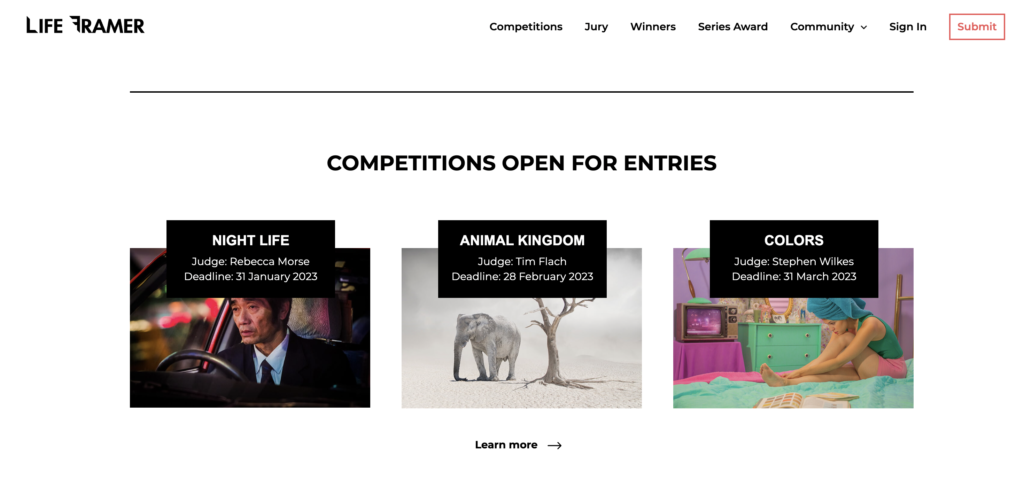If you are on a mission to create interest in your photography and perhaps attract clients, one of the most important and effective things you can do for yourself is to have a portfolio.
Creating a portfolio is, in theory, incredibly simple — everything is “drag-n-drop” now, so all you have to do is fill in all the spaces on a template and you’re all set.
But creating a good portfolio isn’t quite that effortless.
Follow the ideas below to learn how to create a photography portfolio that will have the desired effect on all who view it.
1. Know Your Audience
The theme of your portfolio will vary according to whose attention you’re trying to get. Whether you’re looking to bring in more portrait clients, applying for a job or entering an art program, you must cater to a specific audience.
It wouldn’t make any sense to show your street photography to someone who is interested in your portraits, or your food photos to someone interested in decorating their dentist office.
Relevance matters.
Furthermore, knowing your audience isn’t limited to knowing what type of content to provide (portraits, photojournalism, architecture, etc.); you also need to consider what medium to use — print or digital. We’ll discuss this later on.

Edit Like Your Life Depends On It
I’m not referring to post-processing. This is about going through your work and choosing the absolute best images to include in your portfolio.
This stage, perhaps the most difficult stage in creating a portfolio, will require two things from you: lots of time and brutal honesty.
The editing phase isn’t something you should rush through, especially if you’ve got a lot of photos. The more photos you have, the more time it will take you to sift through them and pull out the real gems.
Don’t compromise or take shortcuts. Be honest with yourself — be able to recognize the difference between a photo you like and a photo that’s worthy of your portfolio. Once you feel you’re done with this part, you’re not. Take a day or two away and return with fresh eyes.
If you’re having difficulty being objective (something that’s particularly hard to do when looking at your own work), don’t hesitate to get a trustworthy friend involved.
The final number of photos you include in your portfolio will depend on who you’re showing to, but you generally need no more than 20 images. If you’re showing your work to a client/gallery/agency that asks to see a specific number of photos, then provide them with that exact amount.

The Big Decision: Digital Vs. Print
While digital is most convenient and perfect for something like winning over clients for portrait shoots, there are occasions that will call for you to produce a printed portfolio. A website is a great selling tool and gives a potential client or agency a first impression of your work, but a printed collection provides gravitas.
An online portfolio is a must-have these days. Some people might use a social media platform as a portfolio, but nothing beats having your own website. It doesn’t need to be anything fancy or visually elaborate — in fact, simpler is better.
Your online portfolio design should be clean, easy to navigate and quick to load (avoid Flash).
If you decide to put together a print version of your portfolio (and I think you should) you have a couple of feasible options.

- A photo book
Photo books are especially popular with wedding and portrait photographers because you can hand a book to your clients any time you meet with them. Not only will they get a more personal look at your photos, but they’ll also get a preview of what they can expect when they order prints or books from you.
It’s ideal to have a separate portfolio for each genre of photography you work in, but purchasing several high-quality photo books can be expensive. If this is a concern for you, there’s an alternate solution you might be interested in….
- A screw-post portfolio
Sort of like a luxury binder, a screw-portfolio allows you to add and subtract pages so your portfolio is always up to date and can be anything you need it to be at any time.
While the cost of a quality screw-post portfolio is likely to be more expensive than a single photo book, you’ll only need to buy one.
Final Thoughts
Your portfolio should do more than simply contain beautiful photos — it must also be relevant to its stated intent.
Make sure you show your best work and make sure all those images work well together. And remember, a good portfolio should “flow” — not only in terms of theme but also orientation (don’t make the viewer constantly have to flip from landscape to portrait).
Creating a portfolio will take considerable time and effort but, done well, you will find that it serves as an indispensable asset to your professional aspirations.
Further Reading
- 6 Websites To Help You Create Your Photography Portfolio
- Thinking About An Online Portfolio, Here’s A Quick Look At Adobe Portfolio
- How Creative Writing Can Improve Your Photography Portfolio
- Putting Together a Photography Portfolio – It Really DOES Matter How You Do it





2 Comments
I created my portfolio took a lot of time and effort and it was worth a lot, now I’m starting to get results thanks for the tips.
Really creating a portfolio is not that easy, but the effort is worth it just, after I did mine I had 5 times more client, as I am freelance got everything else.